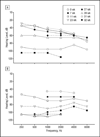Audiologic phenotype and progression in GJB2 (Connexin 26) hearing loss
- PMID: 20083784
- PMCID: PMC4528189
- DOI: 10.1001/archoto.2009.202
Audiologic phenotype and progression in GJB2 (Connexin 26) hearing loss
Abstract
Objectives: To document the audiologic phenotype of children with biallelic GJB2 (connexin 26) mutations, and to correlate it with the genotype.
Design: Prospective, observational study.
Setting: Tertiary care children's hospital.
Patients: Infants and children with sensorineural hearing loss (SNHL).
Intervention: Sequencing of the GJB2 (connexin 26) gene.
Main outcome measures: Degree and progression of SNHL.
Results: From December 1, 1998, through November 30, 2006, 126 children with biallelic GJB2 mutations were identified. Of the 30 different mutations identified, 13 (43%) were truncating and 17 (57%) were nontruncating; 62 patients had 2 truncating, 30 had 1 truncating and 1 nontruncating, and 17 had 2 nontruncating mutations. Eighty-four patients (67%) initially had measurable hearing in the mild to severe range in at least 1 of 4 frequencies (500, 1000, 2000, or 4000 Hz). Of these 84 patients with residual hearing, 47 (56%) had some degree of progressive hearing loss. Patients with 2 truncating mutations had significantly worse hearing compared with all other groups. Patients who had 1 or 2 copies of either an M34T or a V37I allele had the mildest hearing loss.
Conclusions: Hearing loss owing to GJB2 mutations ranges from mild to profound and is usually congenital. More than 50% of patients will experience some hearing loss progression, generally gradually but occasionally precipitously. Hearing loss severity may be influenced by genetic factors, such as the degree of preserved protein function in nontruncating mutations, whereas hearing loss progression may be dependent on factors other than the connexin 26 protein. Genetic counseling for patients with GJB2 mutations should include the variable audiologic phenotype and the possibility of progression.
Figures



Similar articles
-
Audiologic and temporal bone imaging findings in patients with sensorineural hearing loss and GJB2 mutations.Laryngoscope. 2009 Mar;119(3):554-8. doi: 10.1002/lary.20162. Laryngoscope. 2009. PMID: 19235794 Free PMC article.
-
GJB2 mutations and degree of hearing loss: a multicenter study.Am J Hum Genet. 2005 Dec;77(6):945-57. doi: 10.1086/497996. Epub 2005 Oct 19. Am J Hum Genet. 2005. PMID: 16380907 Free PMC article.
-
GJB2 mutations and genotype-phenotype correlation in 335 patients from germany with nonsyndromic sensorineural hearing loss: evidence for additional recessive mutations not detected by current methods.Audiol Neurootol. 2010;15(6):375-82. doi: 10.1159/000297216. Epub 2010 Mar 17. Audiol Neurootol. 2010. PMID: 20234132
-
Connexin 26 (GJB2) Mutations Associated with Non-Syndromic Hearing Loss (NSHL).Indian J Pediatr. 2018 Dec;85(12):1061-1066. doi: 10.1007/s12098-018-2654-8. Epub 2018 Mar 15. Indian J Pediatr. 2018. PMID: 29542069 Review.
-
Compound heterozygosity for dominant and recessive GJB2 mutations in a Tunisian family and association with successful cochlear implant outcome.Int J Pediatr Otorhinolaryngol. 2013 Sep;77(9):1481-4. doi: 10.1016/j.ijporl.2013.06.013. Epub 2013 Jul 12. Int J Pediatr Otorhinolaryngol. 2013. PMID: 23856378 Review.
Cited by
-
Advances in Inner Ear Therapeutics for Hearing Loss in Children.Curr Otorhinolaryngol Rep. 2020 Sep;8(3):285-294. doi: 10.1007/s40136-020-00300-y. Epub 2020 Jul 6. Curr Otorhinolaryngol Rep. 2020. PMID: 36090148 Free PMC article.
-
Etiology and audiological outcomes at 3 years for 364 children in Australia.PLoS One. 2013;8(3):e59624. doi: 10.1371/journal.pone.0059624. Epub 2013 Mar 28. PLoS One. 2013. PMID: 23555729 Free PMC article.
-
Unusual phenotype in 35delG mutation: a case report.J Med Case Rep. 2024 May 12;18(1):241. doi: 10.1186/s13256-024-04559-3. J Med Case Rep. 2024. PMID: 38734626 Free PMC article.
-
The pathological effects of connexin 26 variants related to hearing loss by in silico and in vitro analysis.Hum Genet. 2016 Mar;135(3):287-98. doi: 10.1007/s00439-015-1625-7. Epub 2016 Jan 9. Hum Genet. 2016. PMID: 26749107
-
Simulation-predicted and -explained inheritance model of pathogenicity confirmed by transgenic mice models.Comput Struct Biotechnol J. 2023 Nov 18;21:5698-5711. doi: 10.1016/j.csbj.2023.11.026. eCollection 2023. Comput Struct Biotechnol J. 2023. PMID: 38074473 Free PMC article.
References
-
- Kelsell DP, Dunlop J, Stevens HP, et al. Connexin 26 mutations in hereditary non-syndromic sensorineural deafness. Nature. 1997;387(6628):80–83. - PubMed
-
- Zelante L, Gasparini P, Estivill X, et al. Connexin 26 mutations associated with the most common form of non-syndromic neurosensory autosomal recessive deafness (DFNB1) in Mediterraneans. Hum Mol Genet. 1997;6(9):1605–1609. - PubMed
-
- Ballana E, Ventayol M, Rabionet R, Gasparini P, Estivill X. Connexins and deafness homepage. [Accessed October 26, 2009]; http://davinci.crg.es/deafness/
-
- Denoyelle F, Weil D, Maw MA, et al. Prelingual deafness: high prevalence of a 30delG mutation in the connexin 26 gene. Hum Mol Genet. 1997;6(12):2173–2177. - PubMed

